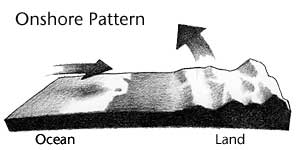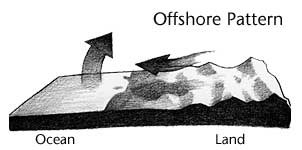![[Ocean Oasis - Teacher's Guide]](images/bnr-oo-tg.gif) |
 |
![[Ocean Oasis - Teacher's Guide]](images/bnr-oo-tg.gif) |
 |
|
|
![[Onshore and Offshore Winds]](images/onshore.gif)
Why do winds blow from the ocean to the land or from the land to the ocean? |
|
In the Film |
The relationship of cold water and hot, dry land creates many wonders. Winds are a natural outcome of differential heating between hot desert and cold water. Winds cause the movement of the surface water that allows cool water to well up from the ocean depths. This cool, nutrient-rich water is the basis of the marine food web. |
|
Concept |
Winds are the result of differential heating. |
|
Objectives |
To demonstrate the relative heating and cooling of dirt and water |
|
Content |
Science, language arts |
|
Background |
When exposed to the heat of the sun, soil warms more quickly than water. As the land warms, so does the air directly above it. As this warm air rises, cooler air from over the ocean flows toward the land. This onshore wind may provide a cooling effect for what would otherwise be an extremely hot region. As the sun goes down, the land cools more rapidly than the water. In early evening the air over the ocean is warmer than the air over the land, and the flow of air is reversed producing an offshore wind. |
|
|
|


![[Materials]](images/materials.gif)
Per group: two 8 oz. plastic cups, dirt, water, 2 thermometers, 2 goosenecked lamps with 60-watt bulbs, pencil, paper, crayons |
![[Procedure]](images/procedure.gif)
(teams, small groups)
|
|
Local Connection
Key Words |
|
Continue to Activity 6: Upwelling |
Teacher's Guide Contents
Field Guide | Site Index |
Ocean Oasis: The Film
|
|
© 2000 San Diego Natural History Museum |